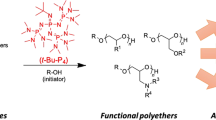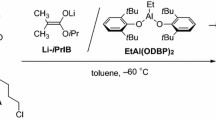Abstract
Phosphazene base, t-BuP2, was employed to catalyze the proton transfer polymerization (PTP) of 2-hydroxyethyl acrylate (HEA), and PTP was further combined with ring-opening polymerization (ROP) to exploit a new type of hybrid copolymerization. The studies on homopolymerization showed that t-BuP2 was a particularly efficient catalyst for the polymerization of HEA at room temperature, giving an excellent monomer conversion. Throughout the polymerization, transesterification reactions were unavoidable, which increased the randomness in the structures of the resulting polymers. The studies on copolymerization showed that t-BuP2 could simultaneously catalyze the hybrid copolymerization via the combination of PTP and ROP at 25 °C. During copolymerization, HEA not only provided hydroxyl groups to initiate the ROP of ε-caprolactone (CL) but also participated in the polymerization as a monomer for PTP. The copolymer composition was approximately equal to the feed ratio, demonstrating the possibility to adjust the polymeric structure by simply changing the monomer feed ratio. This copolymerization reaction provides a simple method for synthesizing degradable functional copolymers from commercially available materials. Hence, it is important not only in polymer chemistry but also in environmental and biomedical engineering.
Similar content being viewed by others
References
Flory, P. J. Principles of polymer chemistry. Cornell University Press, New York, 1953. p.178.
Sanford, M. J.; Zee, N. J. V.; Coates, G. W. Reversible-deactivation anionic alternating ring-opening copolymerization of epoxides and cyclic anhydrides: Access to orthogonally functionalizable multiblock aliphatic polyesters. Chem. Sci.2018, 9, 134–142.
Guégain, E.; Tran, J.; Deguettes, Q.; Nicolas, J. Degradable polymer prodrugs with adjustable activity from drug-initiated radical ring-opening copolymerization. Chem. Sci.2018, 9, 8291–8306.
Hagiopol, C. Copolymerization: Toward a systematic approach. Kluwer Academic/Plenum Publishers, New York, 1999. p.10.
Saini, P. Fundamentals of conjugated polymer blends, copolymers and composites: Synthesis, properties and applications. John Wiley Sons. Inc., Massachusetts, 2015. p. 11.
Rzaev, Z. M. O. Complex-radical copolymerization of N-vinyl pyrrolidone with isostructural analogs of maleic anhydride. Prog. Polym. Sci.2000, 25, 163–217.
Baskaran, D.; Muller, A. Anionic vinyl polymerization—50 Years after Michael Szwarc. Prog. Polym. Sci.2007, 32, 173–219.
Bednarek, M. Branched aliphatic polyesters by ring-opening (co)polymerization. Prog. Polym. Sci.2016, 58, 27–58.
Zhang, G. Hybrid copolymerization. Acta Polymerica Sinica (in Chinese) 2018 668–673.
Song, Q.; Hu, S.; Zhao, J.; Zhang, G. Organocatalytic copolymerization of mixed type monomers. Chinese J. Polym. Sci.2017, 35, 581–601.
Saegusa, T. Spontaneous alternating copolymerization via zwitterion intermediates. Angew. Chem. Int. Ed.1997, 1977, 826–835.
Rivas, B. L.; Canessa, G. S.; Pooley, S. A. Spontaneous copolymerization via zwitterion 1.2-methyl-2-oxazoline and succinic anhydride. Polym. Bull.1983, 9, 417–422.
Bailey, W. J.; Ni, Z.; Wu, S. R. Synthesis of poly-ɛ-caprolactone via a free radical mechanism. Free radical ring-opening polymerization of 2-methylene-1,3-dioxepane. J. Polym. Sci. Part A: Polym. Chem.1985, 20, 3021–3030.
Sinnwell, S.; Ritter, H. Ring-opening homo-and copolymerization of a-methylene-e-caprolactone. Macromolecules2006, 39, 2804–2807.
Kanazawa, A.; Kanaoka, S.; Aoshima, S. Concurrent cationic vinyladdition and ring-opening copolymerization using B(C6F5)3 as a catalyst: Copolymerization of vinyl ethers and isobutylene oxide via crossover propagation reactions. J. Am. Chem. Soc.2013, 135, 9330–9333.
Kanazawa, A.; Kanaoka, S.; Aoshima, S. Rational design of oxirane monomers for efficient crossover reactions in concurrent cationic vinyl-addition and ring-opening copolymerization with vinyl ethers. Macromolecules2014, 47, 6635–6644.
Kanazawa, A.; Kanda, S.; Kanaoka, S.; Aoshima, S. Alkoxyoxirane, a unique cyclic monomer: Controlled cationic homopolymerization mediated by long-lived species and copolymerization with vinyl ether via alkoxy group transfer. Macromolecules2014, 47, 8531–8540.
Kanazawa, A.; Aoshima, S. Cationic terpolymerization of vinyl ethers, oxetane, and ketones via concurrent vinyl-addition, ringopening, and carbonyl-addition mechanisms: Multiblock polymer synthesis and mechanistic investigation. Macromolecules2017, 50, 6595–6605.
Miyamae, Y.; Kanazawa, A.; Tamaso, K. I.; Morino, K.; Ogawa, R.; Aoshima, S. The influence of the substituents of oxiranes on copolymerization with vinyl ethers via concurrent cationic vinyladdition and ring-opening mechanisms. Polym. Chem.2018, 9, 404–413.
Yang, H.; Xu, J.; Pispas, S.; Zhang, G. Hybrid copolymerization of ɛ-caprolactone and methyl methacrylate. Macromolecules2012, 45, 3312–3317.
Zhang, G.; Ma, C. 2017, U. S. Pat., 9701794B2.
Yang, H.; Bai, T.; Xue, X.; Huang, W.; Chen, J.; Qian, X.; Zhang, G.; Jiang, B. A versatile strategy for synthesis of hyperbranched polymers with commercially available methacrylate inimer. RSC Adv.2015, 5, 60401–60408.
Yang, H.; Bai, T.; Xue, X.; Huang, W.; Chen, J.; Qian, X.; Zhang, G.; Jiang, B. A simple route to vinyl-functionalized hyperbranched polymers: Self-condensing anionic copolymerization of allyl methacrylate and hydroxyethyl methacrylate. Polymer2015, 72, 63–68.
Yang, H.; Zhang, J.; Zuo, Y.; Song, Y.; Huang, W.; Jiang, L.; Jiang, Q.; Xue, X.; Jiang, B. Anionic hybrid copolymerization via concurrent oxa-Michael addition and ring-opening polymerizations. Macromol. Chem. Phys.2019 1900147.
Breslow, D.; Hulse, G.; Matlack, A. Synthesis of poly-β-alanine from acrylamide. A novel synthesis of β-alanine. J. Am. Chem. Soc.1957, 79, 3760–3763.
Ogata, N. The transition polymerization of acrylamide. I. On the polymerization condition and the property of polymer. B. Chem. Soc. Jpn.1960, 33, 906–912.
Saegusa, T.; Kobayashi, S.; Kimura, Y. Hydrogen-transfer polymerization of hydroxyalkyl acrylates. Macromolecule1975, 8, 950–952.
Hong, M.; Chen, E. Y. X. Proton-transfer polymerization (HTP): Converting methacrylates to polyesters by an N-heterocyclic carbene. Angew. Chem. Int. Ed.2014, 126, 12094–12100.
Matsuoka, S. I.; Namera, S.; Suzuki, M. Oxa-Michael addition polymerization of acrylates catalyzed by N-heterocyclic carbenes. Polym. Chem.2015, 6, 294–301.
Murase, T.; Matsuoka, S. I.; Suzuki, M. Hydrogen-transfer and condensation-addition polymerizations of acrylic acid. Polym. Chem.2018, 9, 2984–2990.
Roos, K.; Planes, M.; Bakkali-Hassani, C.; Mehats, J.; Vax, A.; Carlotti, S. Solvent-free anionic polymerization of acrylamide: A mechanistic study for the rapid and controlled synthesis of polyamide-3. Macromolecules2016, 49, 2039–2045.
Rozenberg, B. A. Proton-transfer anionic polymerization of vinyl monomers. Des. Monomers Polym.2004, 7, 135–150.
Boileau, S.; Illy, N. Activation in anionic polymerization: Why phosphazene bases are very exciting promoters. Prog. Polym. Sci.2011, 36, 1132–1151.
Alamri, H.; Zhao, J.; Pahovnik, D.; Hadjichristidis, N. Phosphazenecatalyzed ring-opening polymerization of e-caprolactone: Influence of solvents and initiators. Polym. Chem.2014, 5, 5471–5478.
Zhao, J.; Alamri, H.; Hadjichristidis, N. A facile metal-free "graftingfrom" route from acrylamide-based substrate toward complex macromolecular combs. Chem. Commun.2013, 49, 7079–7081.
Zhao, J.; Pahovnik, D.; Gnanou, Y.; Hadjichristidis, N. Phosphazene-promoted metal-free ring-opening polymerization of ethylene oxide Initiated by carboxylic acid. Macromolecules.2014, 47, 1693–1698.
Zhao, J.; Hadjichristidis, N. Polymerization of 5-alkyl δ-lactones catalyzed by diphenyl phosphate and their sequential organocatalytic polymerization with monosubstituted epoxides. Polym. Chem.2015, 6, 2659–2668.
Hu, S.; Dai, G.; Zhao, J. Zhang, G. Ring-opening alternating copolymerization of epoxides and dihydrocoumarin catalyzed by a phosphazene superbase. Macromolecules.2016, 49, 4462–4472.
Zhang, L.; Nederberg, F.; Pratt, R. C.; Waymouth, R. M.; Hedrick, J. L.; Wade, C. G. Phosphazene bases: A new category of organocatalysts for the living ring-opening polymerization of cyclic esters. Macromolecules2007, 40, 4154–4158.
Yang, H.; Bai, T.; Xue, X.; Huang, W.; Chen, J.; Jiang, B. Synthesis of metal-free poly(p-dioxanone) by phosphazene base catalyzed ring-opening polymerization. J. Appl. Polym. Sci.2016, 133, 43030.
Isono, T.; Asai, S.; Satoh, Y.; Takaoka, T.; Tajima, K.; Kakuchi, T.; Satoh, T. Controlled/living ring-opening polymerization of glycidylamine derivatives using t-Bu-P4/alcohol initiating system leading to polyethers with pendant primary, secondary, and tertiary amino Groups. Macromolecules2015, 48, 3217–3229.
Misaka, H.; Sakai, R.; Satoh, T.; Kakuchi, T. Synthesis of high molecular weight and end-functionalized poly(styrene oxide) by living ring-opening polymerization of styrene oxide using the alcohol/phosphazene base initiating system. Macromolecules2011, 44, 9099–9107.
Yang, H.; Zuo, Y.; Zhang, J.; Song, Y.; Huang, W.; Xue, X.; Jiang, Q.; Sun, A.; Jiang, B. Phosphazene-catalyzed oxa-Michael addition click polymerization. Polym. Chem.2018, 9, 4716–4723.
Gibas, M.; Korytkowska-Walach, A. Polymerization of 2- hydroxyethyl acrylate and methacrylate via Michael-type addition. Polym. Bull.2003, 51, 17–22.
Wallach, J. A.; Huang, S. J. Copolymers of itaconic anhydride and methacrylate-terminated poly(lactic acid) macromonomers. Biomacromolecules2000 1174–179.
Acknowledgments
This work was financially supported by the Natural Science Foundation for Excellent Young Scholar of Jiangsu Province (No. BK20170056), the National Natural Science Foundation of China (No. 21304010), the Opening Project of Key Laboratory of Polymer Processing Engineering (South China University of Technology), Ministry of Education, and the Priority Academic Program Development of Jiangsu Higher Education Institutions (PAPD).
Author information
Authors and Affiliations
Corresponding authors
Electronic Supplementary Information
Rights and permissions
About this article
Cite this article
Yang, HJ., Chai, CQ., Zuo, YK. et al. Hybrid Copolymerization via the Combination of Proton Transfer and Ring-opening Polymerization. Chin J Polym Sci 38, 231–239 (2020). https://doi.org/10.1007/s10118-020-2341-x
Received:
Accepted:
Published:
Issue Date:
DOI: https://doi.org/10.1007/s10118-020-2341-x




